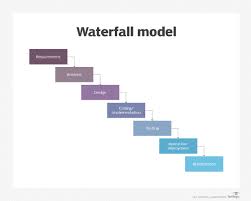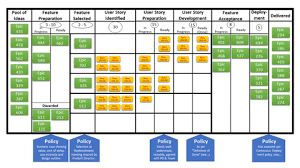The Waterfall Software Development Model: A Comprehensive Guide
When it comes to software development methodologies, the Waterfall model is one of the oldest and most traditional approaches. In this article, we will explore the key aspects of the Waterfall model, its characteristics, advantages, disadvantages, and when it is best suited for use.
What is the Waterfall Model?
The Waterfall model is a linear and sequential approach to software development. It consists of several distinct phases that must be completed in a specific order before moving on to the next phase. The typical phases of the Waterfall model include:
- Requirements gathering and analysis
- System design
- Implementation
- Testing
- Maintenance
Advantages of the Waterfall Model
One of the main advantages of the Waterfall model is its simplicity and clarity. The linear nature of the model makes it easy to understand and manage project progress. Additionally, each phase has well-defined deliverables, which helps in controlling and monitoring the project.
Disadvantages of the Waterfall Model
Despite its advantages, the Waterfall model also has some limitations. One major drawback is its lack of flexibility. Once a phase is completed, it is difficult to go back and make changes without affecting other phases. This can lead to delays and increased costs if changes are required late in the development process.
When to Use the Waterfall Model?
The Waterfall model is best suited for projects where requirements are well understood and unlikely to change significantly during development. It works well for projects with clear objectives and stable technology.
In conclusion, while the Waterfall model may not be suitable for every software development project, it can be an effective approach when used in the right context. Understanding its characteristics, advantages, disadvantages, and when to use it can help project teams make informed decisions about their development methodology.
Top 8 Advantages of Waterfall Software Development
- Clear and well-defined project phases
- Easy to understand and manage project progress
- Each phase has specific deliverables
- Suitable for projects with stable requirements
- Helps in controlling and monitoring the project effectively
- Provides a structured approach to software development
- Works well for projects with clear objectives
- Can be cost-effective for certain types of projects
7 Major Drawbacks of Waterfall Software Development
- Lack of flexibility to accommodate changes in requirements
- High risk of project delays if issues are discovered late in the development process
- Limited stakeholder involvement during early stages may lead to misunderstandings or misalignments
- Difficulty in estimating time and cost accurately due to sequential nature of phases
- Testing is often left until the end, increasing the chances of identifying defects late in the process
- Less adaptive to evolving technology trends and market demands
- Potential for customer dissatisfaction if final product does not meet changing needs
Clear and well-defined project phases
One of the key advantages of the Waterfall software development model is its clear and well-defined project phases. Each phase in the Waterfall model has specific deliverables and objectives, making it easy to understand the progression of the project. This clarity helps project teams stay organized, track progress effectively, and ensure that each phase is completed before moving on to the next. Clear project phases also facilitate better communication among team members and stakeholders, leading to a more structured and controlled development process.
Easy to understand and manage project progress
One of the key advantages of the Waterfall software development model is its simplicity in understanding and managing project progress. The linear nature of the Waterfall approach allows for a clear and structured roadmap, with distinct phases that must be completed sequentially. This makes it easier for project managers and team members to track progress, identify potential bottlenecks, and ensure that the project stays on schedule. By having well-defined deliverables at each stage, stakeholders can easily monitor the project’s advancement and make informed decisions based on its current status.
Each phase has specific deliverables
One of the key advantages of the Waterfall software development model is that each phase has specific deliverables. This structured approach ensures that clear objectives are set for each phase of the project, making it easier to track progress and ensure that project requirements are being met. By defining and achieving specific deliverables at each stage, teams can maintain focus and accountability, leading to a more organized and efficient development process.
Suitable for projects with stable requirements
One key advantage of the Waterfall software development model is its suitability for projects with stable requirements. In such projects, where the scope and objectives are well-defined and unlikely to change significantly during development, the linear and sequential nature of the Waterfall model can be highly effective. By following a structured approach with clear phases, teams can proceed with confidence, knowing that the initial requirements are stable and will not undergo frequent alterations. This stability in requirements allows for a more predictable development process, making the Waterfall model a valuable choice for projects where clarity and consistency are paramount.
Helps in controlling and monitoring the project effectively
One of the key benefits of the Waterfall software development model is its ability to help in controlling and monitoring the project effectively. The linear and sequential nature of the Waterfall approach allows for clear milestones and deliverables at each phase, making it easier to track progress and ensure that the project stays on schedule. This level of control and monitoring can help project managers identify any issues or deviations early on, allowing for timely adjustments to be made to keep the project on track towards successful completion.
Provides a structured approach to software development
One of the key advantages of the Waterfall software development model is that it provides a structured approach to software development. By following a linear and sequential process with clearly defined phases, teams can easily understand the project’s progress and manage it effectively. This structured approach helps in organizing tasks, setting clear milestones, and ensuring that each phase is completed before moving on to the next, ultimately leading to a more controlled and predictable development process.
Works well for projects with clear objectives
One of the key advantages of the Waterfall software development model is its effectiveness in projects with clear objectives. The linear and sequential nature of the Waterfall approach allows for a structured and methodical progression from one phase to the next, ensuring that project goals and requirements are well-defined and understood from the outset. This clarity in objectives helps project teams stay focused and on track, leading to a higher likelihood of successful project completion within scope, budget, and schedule.
Can be cost-effective for certain types of projects
One of the key advantages of the Waterfall software development model is its potential cost-effectiveness for certain types of projects. By following a sequential and well-defined process, the Waterfall model can help in accurately estimating project costs upfront. This can be particularly beneficial for projects with clear and stable requirements, where changes are unlikely to occur frequently. The structured nature of the Waterfall model allows for better budget planning and resource allocation, ultimately leading to cost savings in the long run.
Lack of flexibility to accommodate changes in requirements
One significant drawback of the Waterfall software development model is its lack of flexibility to accommodate changes in requirements. Once a phase is completed, it becomes challenging to go back and make modifications without impacting the entire project timeline. This rigidity can lead to delays, increased costs, and potential rework if requirements change or new insights emerge during the development process. The inability to adapt to changing needs can hinder the overall success and efficiency of a project under the Waterfall model.
High risk of project delays if issues are discovered late in the development process
One significant drawback of the Waterfall software development model is the high risk of project delays if issues are discovered late in the development process. Since the Waterfall model follows a linear and sequential approach, with each phase building upon the previous one, any problems or changes identified late in the process can have a cascading effect on subsequent phases. This can lead to delays in project timelines, increased costs, and potential rework efforts to address the issues, making it challenging to meet project deadlines and deliver on time.
Limited stakeholder involvement during early stages may lead to misunderstandings or misalignments
One significant drawback of the Waterfall software development model is the limited stakeholder involvement during the early stages of the project. This lack of active engagement from stakeholders can result in misunderstandings or misalignments between the development team and the stakeholders regarding project requirements and expectations. Without continuous feedback and input from stakeholders throughout the development process, there is a higher risk of delivering a product that does not fully meet their needs or expectations. This can lead to costly rework, delays, and ultimately, dissatisfaction among stakeholders.
Difficulty in estimating time and cost accurately due to sequential nature of phases
One significant drawback of the Waterfall software development model is the challenge in accurately estimating time and cost. This difficulty arises from the model’s sequential nature, where each phase must be completed before moving on to the next. If unforeseen issues or changes arise during a later phase, it can disrupt the entire project timeline and budget, making it hard to predict with precision how long each phase will take and how much it will cost. This lack of flexibility can lead to delays and budget overruns, highlighting a key limitation of the Waterfall approach in today’s dynamic and rapidly evolving software development landscape.
Testing is often left until the end, increasing the chances of identifying defects late in the process
One significant drawback of the Waterfall software development model is that testing is typically deferred until the end of the project. This approach increases the risk of identifying defects late in the process, making it more challenging and costly to address them. By postponing testing until the final stages, developers may discover critical issues that require substantial rework, impacting project timelines and budgets. This delay in testing can result in a higher likelihood of delivering a product with quality issues, ultimately affecting customer satisfaction and overall project success.
Less adaptive to evolving technology trends and market demands
One significant drawback of the Waterfall software development model is its limited adaptability to changing technology trends and market demands. Due to its sequential nature, where each phase must be completed before moving on to the next, the Waterfall model can struggle to accommodate sudden shifts in technology or market requirements. This inflexibility can result in delays, increased costs, and potential obsolescence of the final product if it fails to meet current industry standards or customer expectations.
Potential for customer dissatisfaction if final product does not meet changing needs
One significant drawback of the Waterfall software development model is the potential for customer dissatisfaction if the final product does not meet changing needs. Since the Waterfall model follows a strict sequential process where requirements are defined upfront and changes are difficult to accommodate once development has begun, there is a risk that the end product may not align with evolving customer expectations. This lack of flexibility can lead to frustration and disappointment among customers who may find that their needs have shifted during the course of the project but are unable to incorporate those changes without significant delays and additional costs.



